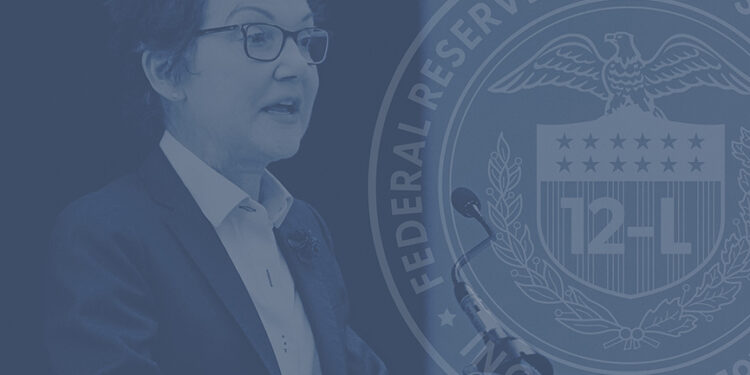It’s wonderful to be here today. I am honored to be speaking with a wide array of audiences—the participants of the 35th Annual Spencer Fox Eccles Convocation, members of the Utah Chapter of the National Association of Corporate Directors, and members of the broader Salt Lake community. Thank you so much for having me.
I last visited Utah back in April. The new Administration had begun to provide early details of its policy initiatives, and businesses, households, and communities were working hard to understand their impacts. Uncertainty was a common refrain. Worries about paralysis, stagnation, even recession dominated the news. The national conversation had shifted from confidence to concern (for example, see the small business optimism series in National Federation of Independent Business 2025).
Then I landed in Salt Lake.
Driving through town, I saw activity. Lots of it. Full parking lots, busy retail outlets, and, most notably, construction cranes.
Cranes tell us a lot. It’s expensive to put up cranes and to keep them working. Businesses only do it when they see promise in the future. Active cranes, and more being assembled, meant that people were adapting, planning, and continuing to move forward. The world had changed, uncertainty had risen, but it did not mean stasis—at least not here in Utah.
That dynamic, the ability to move forward even when things are evolving, is the topic of my remarks today. How to steadily keep moving in the face of change.
Steps for Steadiness
You’ll notice, I said, steadily moving forward. Not heedlessly, recklessly, or haphazardly. But steadily, taking time to consider the situation, assess the risks and the opportunities, and plot a course that works in the evolving environment.
It turns out, that’s what businesses here in Utah had done. As I learned during my visit, they had stepped back, evaluated the changing landscape, and kept the cranes going. Purposefully and with intention.
So, how do you make those types of decisions, when uncertainty and change surround you? The first step is to know your goals. If you’re working on a degree program, your goals could be building and developing your skills and interests. For businesses, it might be expanding your market or increasing brand value. As a monetary policymaker, I’m focused on the dual mandate that Congress gave us: price stability and maximum employment.
Your goals are your foundation. An anchor that keeps you tethered to your values and aspirations and focused on what is important in times of change.
With those goals in mind, you assess. Understand the change you face. Is it going to affect you directly, is it going to last, what are the implications? As students, AI is probably on your mind. Asking how it will impact your studies and your career goals is essential to making good decisions. As corporate directors, you’re likely also thinking about AI, as well as immigration, tariffs, deregulation, and taxes. As a policymaker, I am focused on all of those developments and how they might shape the economy today and in the future.
This reflection, questioning, and analysis enables us to assess the tradeoffs and decide the next steps. Take more classes. Put up a crane. Change the interest rate.
And then it all begins again. Anchor. Assess. Decide. The virtuous cycle of remaining steady through change.
The Path for Policy
Now, you might wonder if this really works. Does steadiness really deliver reliable outcomes?
I submit that Utah is proof. You can see it in the data. Utah is a national leader in growth and employment. According to the latest data from the U.S. Bureau of Labor Statistics, payroll employment growth in Utah was 1.7% over the 12 months through August 2025, nearly double the national pace of 0.9%; similarly, data from the U.S. Bureau of Economic Analysis show notably more rapid GDP growth in Utah than in the nation overall over the past four quarters. This is a place where entrepreneurs take smart risks—think Silicon Slopes, the Olympics, and countless other businesses and initiatives. A role model for steadiness and success that lasts.
Monetary policymakers also must practice steadiness. Making reasoned decisions that support our mandated goals over time.
Indeed, we’ve relied on steadiness to navigate the changing economic landscape over the course of this year.
As I mentioned, Congress legislated two monetary policy goals for the Federal Reserve: stable prices and maximum employment. No matter what happens in the economy, these goals are our anchor. All of our decisions are made in support of achieving those objectives for the American people (Board of Governors 2025a).
The challenge, of course, is determining how best to do that. Especially when the economy is rapidly evolving and we don’t have perfect clarity about how conditions will evolve. And this is where it’s important to step back and assess.
Earlier in the year, there was a lot we didn’t know. Measures of uncertainty were rising sharply (see, for example, Mertens 2025). Households and businesses were worried that tariff and immigration policies could rekindle inflation or slow the labor market and growth. Commentators and financial market participants wondered if the Fed would need to step in, raising interest rates to combat inflation or lowering them to support growth.
Up until last week, the FOMC did neither. Instead, we looked at inflation and how much it exceeded our goal for price stability. We looked at unemployment and how close it was to our maximum employment objective. We considered the Administration’s emerging policies, consulting history, economic models, scenario analysis, and the range of incoming data. Most importantly, we talked to people. We asked businesses how they were feeling, but also what they were doing. We talked to consumers, workers, and communities, and listened to what they told us about their concerns and their actions.
What we determined was that the economy was doing okay. We didn’t have to race in, but we needed to continue to monitor. Risks were on the horizon, but there were also positives in the mix, and it was appropriate to watch how conditions evolved. Most importantly, it was critical to stay focused on our commitment to bring inflation back to our 2% goal. So, we left the interest rate unchanged, keeping policy modestly restrictive, continuing to put downward pressure on inflation. And we actively watched the labor market to ensure there were no signs of stumbling.
Deciding to collect more information is not a passive state. It is prudent preparation for taking action when the time is right. That moment came last week. At our most recent FOMC meeting, we lowered the policy rate by 25 basis points. A decision I fully supported.
The decision was based on information and data. Growth, consumer spending, and the labor market had slowed. Growth in real personal consumption expenditures fell from 3.1% last year to 1.0% for the first half of this year (annualized), while real GDP growth fell from 2.5% to 1.4%. The annualized rate of payroll employment growth fell from 1.3% last year to 0.2% over the past four months through August. Also, inflation had risen less than expected, remaining largely confined to sectors directly affected by tariffs (see Federal Reserve Bank of Philadelphia 2025 for revisions to private-sector inflation forecasts and Federal Reserve Bank of San Francisco 2025 for goods inflation data). The risks to the economy had shifted, and it was time to act.
Managing change isn’t a one-time thing. You must keep at it. Moving forward, it is likely that further policy adjustments will be needed as we work to restore price stability while supporting the labor market. This comes through in our most recent projections. The FOMC’s most recent Summary of Economic Projections shows that Committee members in general expect further cuts this year and next (Board of Governors 2025b). But these are projections, not promises, and making good decisions will require us to anchor on our objectives, assess the tradeoffs, and decide, again and again.
Steady, Not Static
So, let me return to where I began. Flying into Salt Lake last April. On the ride over, I caught up on the news. It felt pessimistic, worried about change, nervous about uncertainty. The cranes said something different.
As you start your academic year, I want you to think about those cranes. Remind yourself that change and uncertainty are normal parts of life. And that people move through them all the time.
But you can’t leave it to luck. Being steady through change takes intention. And it takes commitment. Commitment to your goals, to collecting the evidence, to deciding. And most of all, it takes a commitment to be humble. Willing to repeat the process of anchoring, assessing, and deciding each time a new change comes your way.
In my view, this is the success of the Eccles family. It is the success of the businesses who put up those cranes. And it is also your success. The success that you’ve started as you begin another academic year.
Thank you, and I look forward to our discussion.
References
Board of Governors of the Federal Reserve System. 2025a. “Statement on Longer-Run Goals and Monetary Policy Strategy.” Adopted effective January 24, 2012; as amended effective August 22, 2025.
Board of Governors of the Federal Reserve System. 2025b. “Summary of Economic Projections.” September 17.
Federal Reserve Bank of Philadelphia. 2025. “Third Quarter 2025 Survey of Professional Forecasters.” August 15.
Federal Reserve Bank of San Francisco. 2025. “PCE Inflation Contributions from Goods and Services.”
Mertens, Thomas. 2025. “SF FedViews: July 17, 2025.” Federal Reserve Bank of San Francisco.
National Federation of Independent Business. 2025. “Small Business Economic Trends.” August.
Copyright for syndicated content belongs to the linked Source link






